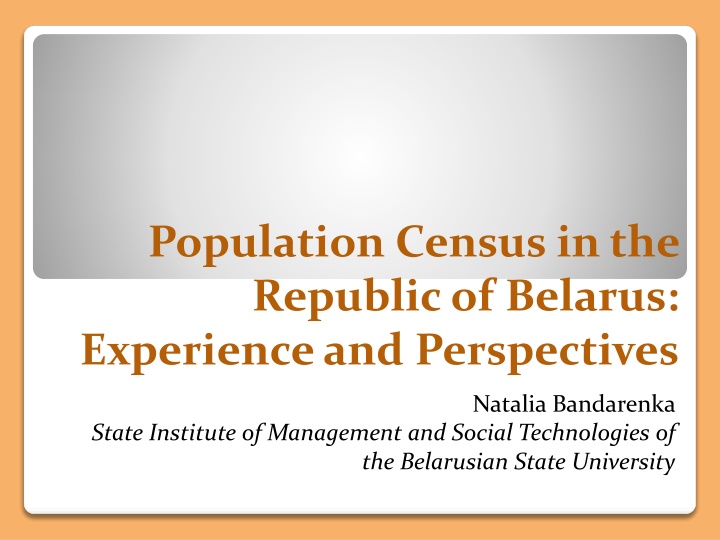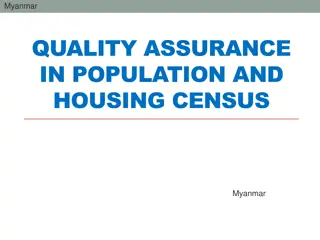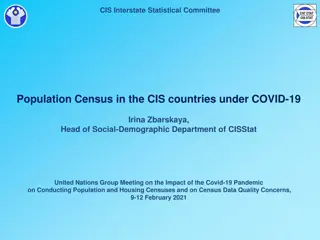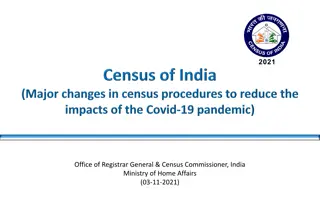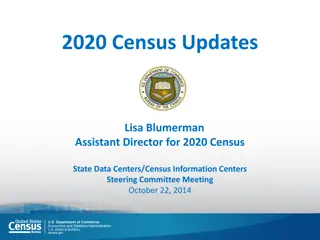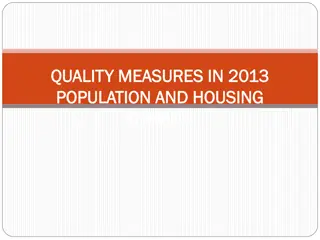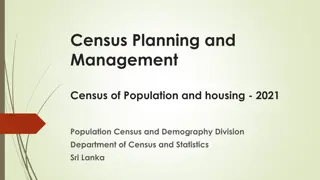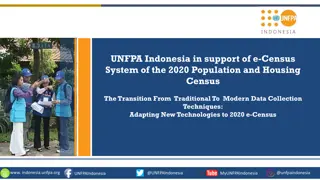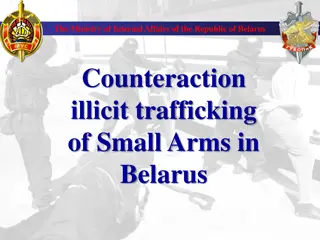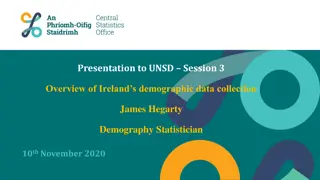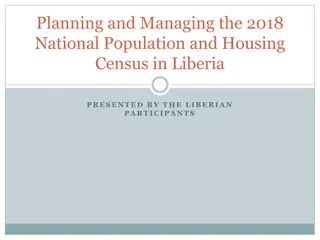Population Census in the Republic of Belarus: History, Principles, and Significance
The Population Census in the Republic of Belarus has a rich history, with nine previous counts conducted since 1897. This census provides essential demographic data, including information on sex, age, nationality, education, marital status, and more. The census program in Belarus is based on fundamental principles such as universality, confidentiality, and centralization. Regular population censuses play a vital role in understanding the structure and dynamics of the population.
Download Presentation

Please find below an Image/Link to download the presentation.
The content on the website is provided AS IS for your information and personal use only. It may not be sold, licensed, or shared on other websites without obtaining consent from the author.If you encounter any issues during the download, it is possible that the publisher has removed the file from their server.
You are allowed to download the files provided on this website for personal or commercial use, subject to the condition that they are used lawfully. All files are the property of their respective owners.
The content on the website is provided AS IS for your information and personal use only. It may not be sold, licensed, or shared on other websites without obtaining consent from the author.
E N D
Presentation Transcript
Population Census in the Republic of Belarus: Experience and Perspectives Natalia Bandarenka State Institute of Management and Social Technologies of the Belarusian State University
Relevance of the research subject The population census provides unique information about the size and structure of the population by sex, age, nationality, education, marital status, occupation and other characteristics It provides demographic indicators at the level of the smallest administrative-territorial units These indicators are comparable between the territories since they relate to a single moment of time
History in the Republic of Belarus Within the borders of modern Belarus, the population census has been conducted 9 times: in 1897, 1926, 1937, 1959, 1970, 1979 , 1989. in 1949 because the heads of the country did not want to show the true losses of the World War II in 1969 because of the difficult economic situation (the census was held in 1970 coinciding with the centenary of Lenin's birth) In the history of independent Belarus two censuses have been held: in 1999 and in 2009.
Basic principles of carrying out a population census in Belarus: universality (a census covers all the territory and all the population); simultaneity (all data collected during the census belong to one certain and predetermined moment); unified program of a census: collecting data by the same features, characteristics specified in the census form, foreach citizen enumerated; self-identification: all information is collected only from the words of the respondents;
Basic principles of carrying out a population census in Belarus: confidentiality (the prohibition of informing someone about personal information received about the census during the census); strict centralization of census management: the state assumes responsibility for conducting, monitoring and financing the census; regularityof thecensus.
The census program consists of three sections : 1. n address part (the name and address of a person, their relation to the head of the family/household); 2. Thecensus program itself (personal demographic , social and economic characteristics, ethnic characteristics; the questions connected with studying population reproduction; migration); 3. The questions connected with other survey (determined by the objectives of this particular census).
Population Census in 1999 In 1999 the population census was conducted in Belarus from February 16 to February 23 - 33 thousand specialists were engaged in the census; each specialist was supposed to interview people from 25 to 40 apartments a day; the method of the census was face-to-face interviewing - -
Population Census in 1999 Unlike previous censuses only the permanent population was enumerated but not present population as before. In developing the census program, the 1989 program was used as the basis, but with significant changes (instead of 13 main questions the program included 17). The questionnaire was not only in Russian, but also in Belarusian.
Population Census in 1999 For the first time not only registered but also unregistered marriage was taken into account; The question about how many children a family not only has but also plans to have was included; The questionnaire asked not just "What is your native language?" as it is done in other countries and what language the person speaks at home and what other languages they are fluent in; The question of how many sources of livelihood were available was included for the first time.
Population Census in 2009 In 2009 the population census was conducted from October 14 to October 24. The duration of the census increased from 8 to 11 days that allowed to reduce the load on the specialist to 300 people and, thereby, to increase the quality of the survey. More than 48 thousand temporary specialists were engaged in the population census.
Population Census in 2009 For the first time in the population census of Belarus there were more than 3000 of fixed census stations, where respondents could indicate information about themselves the pilot (test) census showed that about 5% of the population living in the pilot census area visited such stations The poll of the respondents and filling out the questionnaires were carried out in Belarusian or Russian at the request of the respondent
Population Census in 2009 The census program included 9 main topics: The number and location of the population; Demographic characteristics; Level of education; Socio-economic characteristics; National composition of the population, citizenship; Population migration; Characteristics of households; Housing conditions; Population temporarily residing in the territory of the Republic of Belarus.
The distinctive features of the 2009 census program The census program in 2009 contained an additional question about the type of educational institution in which the respondentstudied The program for the first time included the information characterizing the labor migration now the information about the location of the main workplace of labor migrants is given in combination with their age, level of education, status in employment, occupation, type of economic activity, place of residence
Population Census in 2019 The next population census will be conducted in 2019 from October 4 to October 30. The duration of the census will be 27 days. On October 4,5,6 2019 the census will be conducted at fixed stations from October 7 to October 11, 2019, the lists will be updated from October 12 to October 30, 2019 a round of interviewing by specially trained people in households will be carried out (at the same time fixed stations continue to work)
Population Census in 2019 The population census 2019 will be conducted in three ways: face-to-face interviewing by a specialist; on fixed stations; by the Internet (the principle of self- registration).
The innovation of the forthcoming census the questionnaire with tablet computers in which census forms will be downloaded electronically, as well as maps of sites with addresses and house outlines. replacement of traditional paper
Advantages: It will provide high quality of filling out questionnaires due to the connection to the control system. It is provided to use the information system "Register of the Population" as the basis for filling out the address part of the questionnaire. It will allow to obtain automatically about 20% of the information needed to fill out the questionnaire (a full name, the identification number, date and place of birth, gender, citizenship, place of residence and place of stay). Only the remaining missing information will be obtained through interviewing.
Advantages: Using tablets will also increase the load per specialist to 750 people (compared to 300 in 2009). in 2019 it is planned to engage about 2.5 thousand people for the census (in 2009 the number was 7,5 thousand people). Thus, the number of temporary census staff will be reduced by 3 times in comparison with the previous census.
The innovation of the forthcoming census Within agricultural census will be held in the first time in Belarus (which must be conducted once in 10 years according to the recommendations of FAO) the population census of 2019 the
The relevance of the agricultural census in Belarus The National Statistical Committee provides: - current statistical accounting of the main agricultural organizations activity - selective monitoring of agricultural activity of the citizens having personal subsidiary farms and constantly living in rural areas (a survey of private subsidiary plots in rural areas) (from 2011). The population carrying out agricultural activities in urban areas, in garden associations, seasonal houses and summer cottages is not examined. It caused a need for inclusion of questions about their agricultural activity in the census program.
A pilot Population Census in in 2017 The pilot population census has been conducted from October 2 to October 13, 2017 in Molodechnenskydistrict. - during the census 97.9% of the population living in the territory according to information received from administrative sources was taken into account. - 1.7% of number of respondents have refused participation in a census.
A Purpose of the Pilot Population Census Approbation of the census program Approbation of the census methods Approbation of data processing technology Approbation of the training process peoples responsible for the preparation and conduct of the census
What did the pilot census show? The stationary census stations are relevant (about 6% of the population passed the census on them) Filling of questionnaires in electronic format amounted to an average of 5 minutes per person (three times faster than when filling paper questionnaires). In addition, the number of errors in data entry has been significantly reduced (through the connection of a control system) The use of tablets allowed real-time monitoring of the census progress
Problems and difficulties by results of a pilot census The problem of access to accommodation (no doorbells, intercoms faulty, etc.) Existence of the empty accommodation Existence of rooms for which visit police officers were attracted (the people leading an asocial life live) Concern of the population that census data can be used for other purposes (for example, for the tax inspection, etc.)
Problems and difficulties by results of a pilot census Concern of the population that the census data may entail the application of administrative procedures if the place of registration does not coincide with the place of actual residence Refusal of the population to answer certain questions (for example, the source of your income, employment issues)
